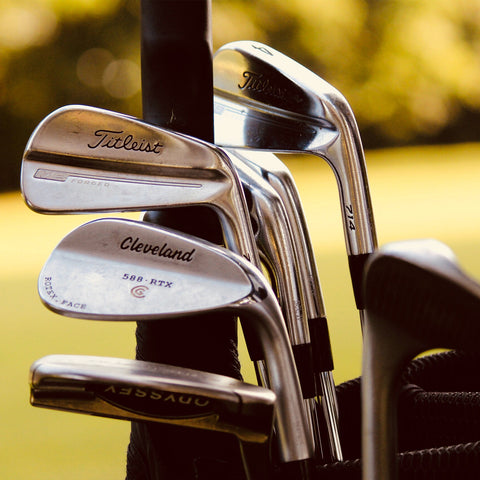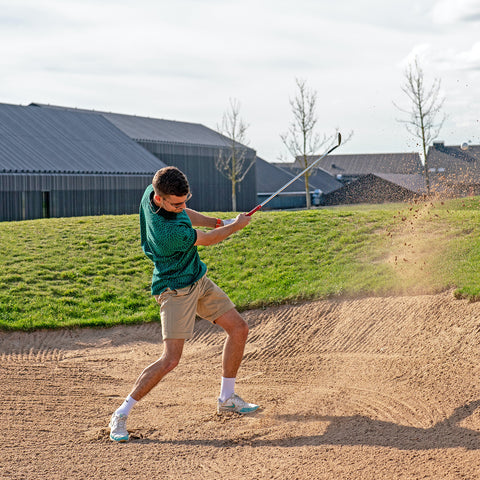What Are The Different Types of Golf Clubs?
The different types of golf clubs are:
- Driver
- Fairway Woods
- Hybrids
- Irons
- Wedges
- Putters
The driver is used for long-distance shots off the tee, the fairway woods are ideal for hitting from the fairway, hybrids offer versatility in various situations, irons are used for precise shots from the fairway or rough, wedges help with approach shots and tricky greenside plays, and putters are essential for the final strokes on the green.
In the next section you can look at each club type more in depth, and get more familiar with the typical clubs a player would have on each round in their bag.

1. Irons
Read Our More In Depth Guide On Irons
These slender yet versatile clubs are the backbone of any golfer's bag. Numbered from 1 to 9, each iron possesses a distinct loft angle and range of distances it can cover. The lower-numbered irons, such as the 3-iron and 4-iron, offer longer shots with less loft, ideal for getting distance from the tee or fairway. As the numbers increase, the loft and control increase, allowing golfers to approach the green with precision. Irons are renowned for their accuracy and are essential for mastering a wide array of shots.

2. Wedges
Read Our More In Depth Guide On Wedges
Wedges are the artisans of the golf club family, specially designed for finesse and short-range accuracy. They come in various types, including gap wedges, sand wedges, and lob wedges. A gap wedge bridges the distance between pitching and sand wedges, excelling in approach shots with moderate loft. The sand wedge, as the name suggests, is the go-to tool for escaping bunkers and navigating tricky lies. The lob wedge, with its steep loft angle, is a magician around the greens, popping the ball sky-high for delicate shots. Wedges offer precision in tight spots, making them indispensable for delicate shots near the pin.

3. Driver
Read Our More In Depth Guide on Drivers
The driver, often referred to as the 1-wood, commands attention as the powerhouse of your golf bag. This long-distance club combines technology and design to deliver awe-inspiring tee shots that set the tone for your game. With its larger clubhead, extended shaft, and sweeping arcs, the driver is designed to maximize distance off the tee. As you step onto the tee box, the driver's potential to launch the ball with impressive speed and distance becomes evident, making it an essential tool for setting up favorable positions for your subsequent shots on the fairway. Harnessing the driver's capabilities requires a blend of technique, confidence, and an understanding of your swing dynamics. When wielded effectively, the driver becomes a force that shapes your course strategy, allowing you to tackle long par 4s and par 5s with authority.

4. Woods
Read Our More In Depth Guide On Woods
Woods are the heavy hitters of the golf club family, designed for power and distance. Traditionally made of wood, modern woods are crafted from advanced materials that optimize speed and control. The driver, a type of wood, is the longest club in the bag and is used for launching the ball off the tee with maximum distance. Fairway woods are versatile tools for long shots from the fairway, while hybrids bridge the gap between irons and woods, offering forgiveness and versatility.

5. Hybrids
Read Our More In Depth Guide On Hybrids
Hybrids, often referred to as "rescue clubs," combine the best of irons and woods. They feature a design that combines the ease of hitting a wood with the precision of an iron. Hybrids are excellent for tricky lies, long approaches, and situations where a full iron might lack the necessary loft. They offer a smoother swing and greater control, making them a popular choice for golfers seeking versatility.

6. Chippers
Read Our More In Depth Guide On Chippers
A chipper golf club is engineered to excel in situations where you need to get the ball off the grass and onto the green with a short, controlled shot. Unlike traditional wedges, a chipper's design is akin to a putter, featuring a flatter face and minimal loft. This unique combination allows you to execute shots that hug the ground, minimizing the risk of overshooting the target.

7. Putters
Read Our More In Depth Guide On Putters
Putting is where games are won or lost, and putters are the brushes that delicately guide the ball into the cup. These clubs are designed for precision, control, and accuracy on the green. Putters come in various styles, including blade putters, mallet putters, and belly putters, ensuring there's plenty of choice to pick from, especially when you're just getting started with putting.
How to Choose the Right Type Golf Club For Which Shot
Golf, often referred to as a sport of inches, teaches us that every stroke counts. Choosing the right club for the task at hand can be a challenge - there's a lot of choice!
Below is a table to help you decide which golf club will play best depending on your current situation on the golf course.
Golf Club Selection Guide
| Situation | Club Choice | Considerations |
|---|---|---|
| Tee Shot (Need Maximum Distance) | Driver | Use when distance is essential and the fairway is wide. |
| Tee Shot (Accuracy Over Distance) | Fairway Woods or Hybrids | Ideal when accuracy is crucial while still needing distance. |
| Approach Shot (Long Distance) | Irons (3-5) | Use for long shots from the fairway or rough. |
| Approach Shot (Short Distance) | Wedges (Pitching, Sand, etc.) | Provides control and accuracy for short-distance shots. |
| Around the Green (Chipping) | Wedges (Sand or Lob) | Offers precision for shots close to the green. |
| Rough (Recovery) | Higher Number Irons (6-9) | Use to get the ball out of thicker grass in the rough. |
| Putting | Putter | Essential for final strokes on the green. |
What Do All These Numbers & Markings On My Clubs Mean?
As you delve deeper into the world of golf clubs, you'll encounter a visual language etched onto each club's surface. These markings aren't mere symbols; they hold the key to the club's characteristics and capabilities.
1. Loft Angle:
One of the most significant markings you'll encounter is the loft angle—a measurement in degrees indicating the club's face angle. This number signifies how much loft the club imparts to the ball at impact. A higher degree corresponds to a higher loft, which, in turn, produces a higher trajectory. Understanding loft angles is pivotal for choosing the right club to achieve the desired shot height and distance.
2. Identifiers Like "P":
You might notice letters such as "P" on your clubs—these are often shorthand for the club's purpose or design. For example, "P" might stand for "Pitching Wedge," indicating the club's use for approach shots around the green. Similarly, "S" might represent a "Sand Wedge," while "L" might denote a "Lob Wedge." These identifiers are valuable in quickly identifying each club's role in your golfing arsenal.
Summary
By understanding the different types of golf clubs in each category, you equip yourself with the knowledge to approach different shots confidently. Whether you're teeing off, navigating the fairway, or making a crucial putt, the right club choice can make all the difference.
Remember, golf is a continuous learning process. Every swing is an opportunity to refine your skills and improve your game. Whether you're a seasoned golfer or just starting out, the journey is marked by growth and progress.
So, as you continue your golfing adventure, keep in mind that each club in your bag is a tool that can help you navigate the challenges of the course. With practice and dedication, you'll develop the ability to choose the right club for every situation and elevate your performance on the greens.
Need help carrying those clubs around the course? We recommend looking at an electric golf trolley - no sore arms when you're ready to tee off at the 15th!
Frequently Asked Questions (FAQs)
What do the different golf clubs mean?
Golf clubs come in various types, including irons, wedges, woods, hybrids, and putters. Each type serves a distinct purpose, contributing to your overall game strategy.
How can you tell the difference between golf clubs?
Golf clubs can be differentiated by their design, loft angle, and use. Woods are known for their larger heads and are used for long-distance shots. Irons come in different numbers, with lower numbers for longer shots and higher numbers for shorter, precise shots. Wedges have higher lofts and are used for delicate shots around the green. Hybrids bridge the gap between irons and woods, and putters are used on the green for precision putting.
What is the difference between a wedge and an iron?
The main difference between wedges and irons lies in their loft angles and purposes. Wedges have higher lofts and are designed for short-range shots that require precision and control, such as chipping and pitching. Irons have lower lofts and cover a broader range of distances, making them versatile for approach shots and fairway play.
Can you use a 9 iron as a pitching wedge?
While a 9 iron and a pitching wedge may have similar loft angles, they are designed for different distances and shots. A pitching wedge is usually better suited for shots closer to the green, providing better control and accuracy, whereas a 9 iron might be used for longer approach shots.
What is an 'A' wedge used for in golf?
An 'A' wedge is commonly known as an approach wedge or gap wedge. It's a type of wedge with a loft angle between a sand wedge and a pitching wedge. The 'A' wedge is used for mid-range approach shots that require a balance of distance and precision.
When should I use a pitching wedge?
A pitching wedge is typically used for approach shots to the green from a moderate distance. It provides a balance of loft and distance, making it suitable for shots where you need the ball to stop quickly on the green.
When should I use a wedge?
Wedges are best used for short-range shots that demand precision and control. They are particularly useful for shots around the green, such as chipping, pitching, and bunker play.
What is the difference between a wedge and a pitching wedge?
A pitching wedge is a specific type of iron with a moderate loft angle, used for approach shots to the green. On the other hand, a wedge is a broader category that includes various types such as gap wedges, sand wedges, and lob wedges. Wedges, in general, have higher loft angles and are designed for short, delicate shots.
Do I need a pitching wedge if I have a sand wedge?
Yes, having both a pitching wedge and a sand wedge in your bag is beneficial. While both clubs have their unique purposes, a pitching wedge is more versatile for approach shots and fairway play, while a sand wedge is specialized for escaping bunkers and high shots around the green.
What does 'P' mean on a golf club?
'P' on a golf club typically stands for 'Pitching Wedge.' It indicates that the club is designed for approach shots to the green from a moderate distance, providing a combination of loft and control.
 Free UK Delivery On Orders Over £25
Free UK Delivery On Orders Over £25 90 Day Returns
90 Day Returns


